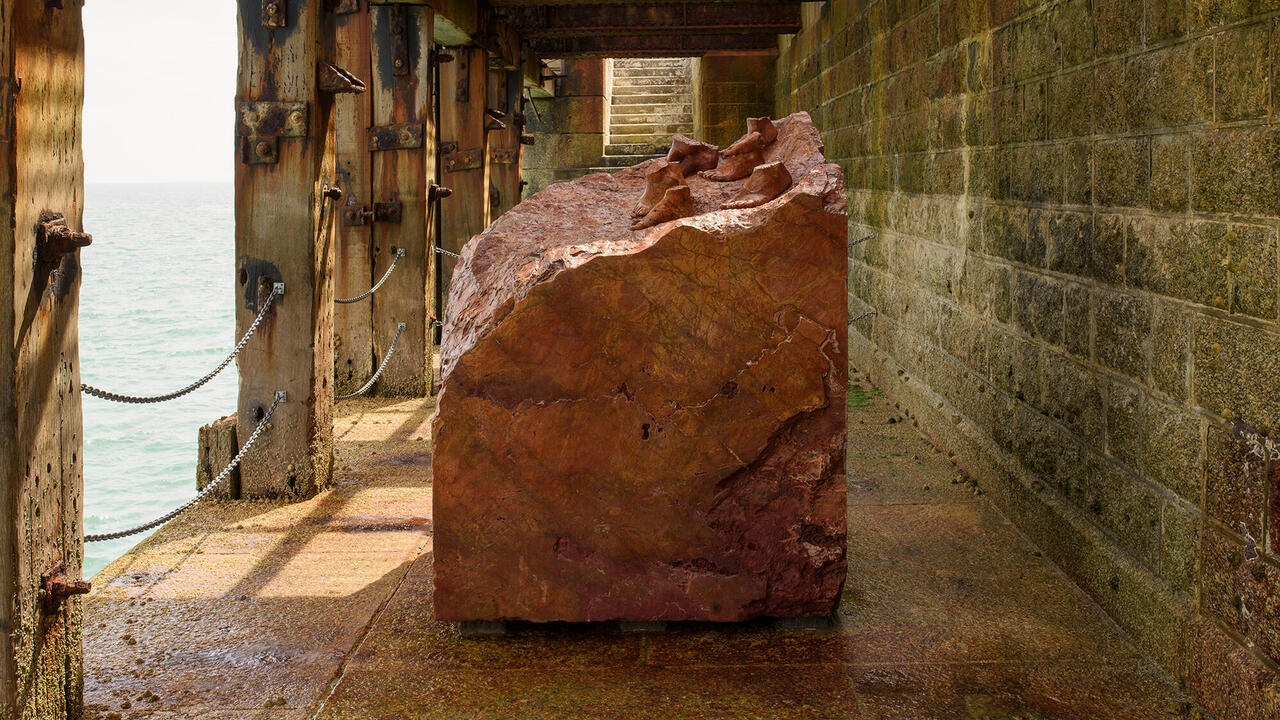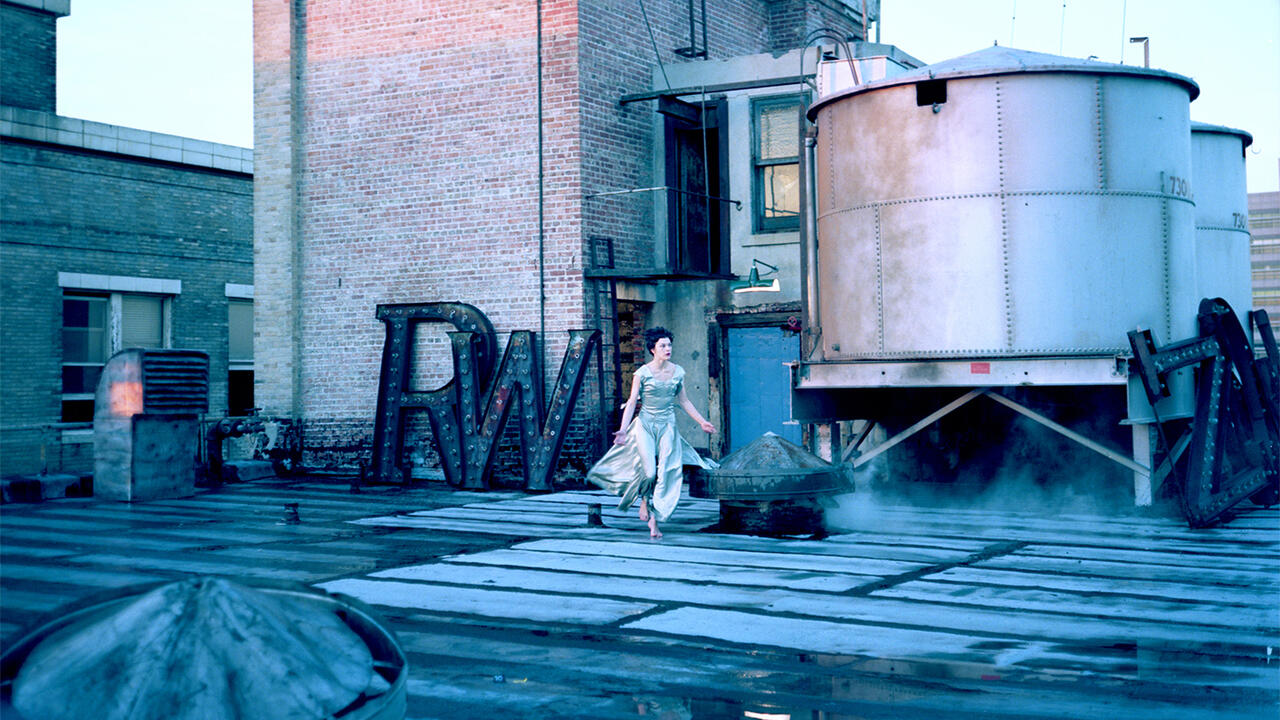One Take: John Gerrard’s Western Flag (Spindletop, Texas)
A digital portrait of the landscape that transformed our planet
A digital portrait of the landscape that transformed our planet

On 10 January 1901, a ragged band of men in a blasted corner of southeast Texas changed the course of history. Following the hunch of a one-armed geologist – whose past included shooting dead a sheriff who interrupted his attempt to burn down a black Baptist church – prospectors dug an exploratory oil well near the Louisiana border. It was a risky investment. Innumerable ‘wildcat’ speculators had bankrupted their creditors by drilling into a Texan landscape considered by most reputable oil men to be dry. Yet, 300 metres down, the drill hit a reservoir so vast that its puncture caused a small earthquake. Spitting out the six-tonne bit, a yellow-black geyser coursed up the borehole and sprang to a height of 45 metres, spilling a volume of petroleum that exceeded the combined production of every other well in the US on that day.

The ‘Lucas Gusher’, at Spindletop, was the largest oil strike the world had ever seen and the starting gun for a boom that would transform Western society and, ultimately, the Earth’s entire ecosystem. The immediate availability of seemingly unlimited supplies of cheap petroleum – the price of oil dropped from two dollars to just three cents per barrel in the wake of the discovery – ensured that the internal combustion engine rather than electric batteries powered the automobiles that would soon criss-cross an American landscape punctuated by gasoline stations. Spindletop laid the foundations for the economic expansions that shaped the 20th century as well as the conflicts for resources and environmental catastrophes that look set to define the 21st.
Two remarkable photographs capture this moment of crisis. The first, taken on the day the well ‘came in’, shows a narrow jet of oil spurting through the latticed wooden framework that supports the rig’s drilling apparatus before, tipped over by the breeze, it cascades down onto the surrounding earth. The second shows the same landscape two years later, overlaid by a tightly packed grid of several hundred derricks operated by newly founded companies, including the first incarnations of ExxonMobil, Gulf Oil and Texaco. Inspired by these images and the industrialized societies they portend, the artist John Gerrard has created a computer-generated portrait of Spindletop as it is today: Western Flag (Spindletop, Texas) (2017). This virtual reconstruction of the birthplace of modernity has been realized in three media: broadcast as a series of guerrilla-style interruptions to regular programming on the British television broadcaster, Channel 4, over 24 hours on 22 April; streamed online; and erected in the courtyard of London’s Somerset House as a vast LED-screen sculpture.

Gerrard’s restaging of what is now a pockmarked post-industrial wasteland places a tall, slim flagpole at its centre. Smoke pours out from seven equally spaced nozzles at its peak, coalescing into a rectangular cloud of thick smoke that billows outwards like a ragged flag in a stiff wind. The sterile ground is littered with what appears to be abandoned machinery, while distant rigs scrape the smooth sky like the few remaining teeth of a broken comb. The camera traces a repetitive circuit at head height and walking pace around the flagpole, like a dog testing the end of its tether, while the simulation follows the same unending rhythms as the location it recreates: when night falls on Texas, so is the black flag cast into darkness. The scene suggests an aggression – a burning flag planted in the land, its image relayed as a warning to those who might oppose its claim – at the same time as it intimates mourning for a catastrophe.
Western Flag (Spindletop, Texas) is the latest in Gerrard’s series of uncannily ‘realistic’ digital portraits of physical locations. The scare quotes surrender to a recurring difficulty when writing about the Irish artist’s work, which questions where the boundary between reality and unreality lies. Given that this pin-sharp representation of the Texan landscape is constructed from a comprehensive photographic survey of the site, translated into code, what makes its moving images any less ‘real’ than a digital video of the same location? Simple categorical distinctions are further complicated by the fact that this live simulation ‘exists’ as a piece of software whose instructions are rendered in real time by a computer at the rate of 50 frames per second. Every image is both unique and instantly discarded, meaning that the work is closer in spirit to the live interpretation of a score than the transmission of pre-recorded information. The TV interventions, for instance, required two computers – one serving as an emergency understudy – to be installed into the Channel 4 mainframe. There, they performed the work continuously for 24 hours, cutting occasionally into broadcasts. The fidelity to real life, simulated by the passage of day into night, is consistent with the live nature of the work, constituted of infinitesimal moments that disappear without hope of recovery.
Western Flag evokes the landscape that hosts so many examples of land art, perhaps the quintessential expression of the oil age.
Since Western Flag is not a record of a place but a live interpretation of it, the work has no enduring form beyond that which survives in the memory of its audience; this is consistent with the artist’s intention to provoke critical thought rather than simply memorialize or reproduce. From a Google server facility to a mechanized pig farm in the American midwest, Gerrard’s previous choice of subjects have drawn attention to hidden infrastructures. Western Flag extends that preoccupation by giving visible form to the invisible offshoot of industrial production – carbon dioxide – which has contributed to halving the earth’s biodiversity since Spindletop and threatens to make large swathes of its surface uninhabitable. The invisible systems and processes upon which our gilded Western lifestyles depend are further evoked by the carbon flag’s play upon the double entendre of ‘power’: energy and force. Alluding to the different means by which our dependence on oil manifests in the real world, Western Flag might helpfully be understood as a companion piece to Gerrard’s apocalyptic Dust Storm (Texas) (2007), based on an archival photograph from the 1930s of a vast particulate cloud engulfing a farmhouse during the Dust Bowl. That work showed the first great ecological catastrophe of the petroleum age, caused by the conversion of vast grassland plains into cropland suitable for industrial farming by gasoline tractors and harvesters; the eerie absence of any higher form of life in Western Flag might be taken to hint at the longer-term impacts of humanity’s continued dependence upon fossil fuels. No citizen of the United Kingdom or United States, meanwhile, should need reminding that the expropriation of oil under the flimsy pretext of national security imperatives has motivated catastrophic military interventions.
Yet, for all its polemical punch, this swirling black flag carries an ambiguity and emotional register that – crucially for a work of public art intended to engender its audience’s active engagement with live issues rather than browbeat – distinguishes it from agitprop or investigative journalism. It calls to my mind, for example, the childhood memory of walking with my grandfather across the British city of Preston towards the cattle market in which he worked. From a street overlooking the city, he was apt to point out the few remaining cotton factory chimney stacks, as well as marking the places where dozens of others once stood. Their dwindling number was, for him, a cause for lament, an index of the city’s decline from an industrial powerhouse of whose status its citizens were proud. I envisioned the horizon jagged with chimneys, each coughing thick smoke into the sky – an imagined landscape that retains a romantic quality undiminished by its obvious perversity. (My grandmother, who had worked in one of the factories as a teenager, did not suffer from the same nostalgia.)

In art-historical terms, the scenery of Western Flag evokes the landscape that hosts so many examples of land art – perhaps the quintessential expression of the oil age. Speaking on the phone, Gerrard cites Robert Smithson’s Asphalt Rundown (1969) – for which the artist unloaded a dumper truck of hot asphalt down the steep edge of an open mine in Italy – as possessing a similarly unconscionable allure. Smithson’s preoccupations with entropy and the cooling of the universe seem now darkly ironic in the context of global warming being accelerated by the earth-moving machines of which he was so fond. But it is difficult not to envy the freedom of those times even as we condemn their irresponsibility. Something of that wistfulness imbues Western Flag, a symbolic conflation of the triumphalist nationalism for which flags are the established metonym and the longed-for return to a mythical past in the highly industrialized, heavily polluting ‘heartlands’ that has catalyzed its resurgence. That the political Right on both sides of the Atlantic has capitalized upon the nostalgia of industrial decline, while the Left has been slow to recognize the debilitating effects on communities of the associated loss not only of jobs but of civic identity, suggests that this work can be read as social, as much as environmental, commentary.
For the broadcast on Channel 4, Western Flag was cut into short clips that interrupted regular programming without any title card or explanation – like hacks from a hostile power. This stark juxtaposition of the ‘real’ and ‘virtual’ was also central to the freestanding sculpture’s disconcerting effect at Somerset House, which had no frame to separate its post-apocalyptic landscape from the elegant neoclassical architecture that served as a backdrop. Seen from the gate that protects Somerset House from the Strand, the effect was of a vast photomontage in the style of John Stezaker: one image rudely superimposed onto another. Staked in a palace at the centre of London and beamed directly into our living rooms, Western Flag brought the consequences of the petroleum age home.
John Gerrard lives in Dublin, Ireland, and Vienna, Austria. His work is currently included in ‘Electricity: The Spark of Life’, at the Wellcome Collection, London, UK, until 25 June, and ‘A Handful of Dust’ at Whitechapel Gallery, London, until 3 September. Western Flag (Spindletop, Texas) was broadcast on Channel 4, streamed on their website, and installed in the courtyard of Somerset House, London, in April.
Main image: John Gerrard, Western Flag (Spindletop, Texas), 2017, installation view, Somerset House, London. Courtesy: the artist, Thomas Dane Gallery, London, and Simon Preston Gallery, New York; photograph: Damian Griffiths























